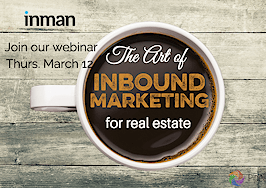Have you noticed the abundance of self-checkout lanes popping up in local stores? Do you use a bank app for mobile deposits? Is Yelp your first stop when you want to try a new restaurant for dinner? Chances are your answer to one or all of these questions is yes — and you’re not alone — but what do all of these things have to do with real estate?
Today, instead of having to turn to salespeople for information about products and services, consumers are instead turning to Google and peer-review sites. Because of this shift, consumers have developed a different mindset when it comes to considering a purchase. A mindset that makes the idea of having to speak to a human being to accomplish their purchase goal seems like a chore.
This new process, defined by Hubspot as “The Buyer’s Journey,” is affecting traditional marketing in a big way. Interruption tactics (a term coined by entrepreneur and marketer Seth Godin) have become less and less effective, a factor that is likely impacting your real estate business right now.
As recently as five years ago, a potential buyer who wanted to look at homes for sale was likely to rely on a listings book, drive around the neighborhood searching for “For Sale” signs, call an agent or pick up a newspaper to see available listings. Today, that same potential buyer is far more likely to begin their search online.
In fact, the National Association of Realtors’ 2015 Home Buyer & Seller Generation Trends report states that 43 percent of all homebuyers began their home search online. Additionally, 43 percent of all buyers found the home they purchased online.
This data suggests the chances of an agent speaking with a lead before they’ve spent time doing their own research are slim to none. In fact, CustomerThink.com states that consumers don’t want to deal with a salesperson in any capacity until they are 70 percent of the way through their buying process. But real estate is a relationship business — so how do you connect with leads who aren’t ready to talk to you?
You use inbound marketing.
Inbound marketing is, in the words of Voltier Digital, “the dawn of marketing you won’t hate.” Historically, most marketing techniques have been interruptive.
A cold call, TV commercial or direct mailer are not things a consumer seeks out — it’s something forced upon them, that interrupts their day. Inbound marketing — which has been around for about eight years but has only recently started to become considered a best business practice — steers clear of interruptive tactics. Instead, the goal of real estate inbound marketing is to attract leads to your website or blog with interesting, helpful content.
Here are some examples of helpful content you can provide to your leads:
- List of area schools and demographic data on each.
- Details on what comps to consider when determining a home’s value.
- Advice on what type of loan to consider based on budget and lifestyle factors.
- Tips on how to get through the real estate process for first-time homebuyers and sellers.
- Information on which home improvements provide the best return on investment.
By providing this content and making it searchable online, you will be targeting your ideal leads, providing them with helpful information, and establishing trust and credibility without saying a word. That’s how effective inbound marketing is designed to work.
Now that you see the value, let’s talk about how to incorporate inbound marketing methodology into your real estate business in a meaningful way.
If you’re just getting started, follow these five simple steps:
- Learn about inbound marketing best practices (and be sure to check out Inman’s recent inbound webinar).
- Identify your target consumer, and build a marketing persona that consists of details on their unique needs, questions and concerns.
- Start creating shareable content that is readily available to potential clients (not just existing clients).
- Be sure to incorporate search engine optimization best practices for optimum online visibility.
- Promote your content by creating a business blog, adding resources to your website or ramping up your social media presence.
Each small step you complete will serve as a building block that will help you grow your digital footprint and create a permanent database of lead attracting material. As an added benefit, research by Search Engine Journal suggests inbound leads cost 60 percent less than outbound leads — which could mean considerable cost savings for agents. The bottom line is: Consistently incorporating inbound marketing methodology into your business is not optional, it’s a necessary step you must take to achieve business success in 2015 and beyond.
What success have you found with inbound marketing? Please share in the comments section below.
Jessica Schweppe is the marketing content manager for Zurple, a California-based software company that helps agents build relationships through behavioral marketing automation. Prior to Zurple, Jessica held various roles with real estate and startup companies. Today, she’s focused on teaching agents how to use smart marketing strategies to achieve consistent, scalable business growth. In her free time, you will find the native Nebraskan enjoying California’s beautiful beaches. Connect with Jessica on LinkedIn.



